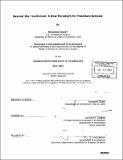| dc.contributor.advisor | Reinhard K. Goethert. | en_US |
| dc.contributor.author | Quadri, Mahjabeen, 1977- | en_US |
| dc.contributor.other | Massachusetts Institute of Technology. Dept. of Architecture. | en_US |
| dc.coverage.spatial | a-pk--- | en_US |
| dc.date.accessioned | 2012-02-29T17:27:57Z | |
| dc.date.available | 2012-02-29T17:27:57Z | |
| dc.date.copyright | 2003 | en_US |
| dc.date.issued | 2003 | en_US |
| dc.identifier.uri | http://hdl.handle.net/1721.1/69448 | |
| dc.description | Thesis (S.M.)--Massachusetts Institute of Technology, Dept. of Architecture, 2003. | en_US |
| dc.description | Includes bibliographical references (leaves i-iii). | en_US |
| dc.description.abstract | Pakistan's greatest resource is its children, but only a small percentage of them make it through primary school. Pakistan needs to improve its literacy rate if it hopes to transition from a developing to a developed country. However, the 2-room government schools found in most parts of the country do not offer any of the amenities of a modern educational institution and most are in a state of disrepair since the government is unable to meet the cost of maintenance. Lack of educational resources and dreary physical conditions are some of the main contributors to the low enrollment and high dropout rates. Presented in the thesis is a proposal for improving teaching and learning conditions of the 2-room government schools, taking into consideration both the limited resources of the government and the poverty of the communities the schools are located in. The thesis is based upon a government school in Manghopir, Karachi that is run by the community. It proposes a framework that makes the school a "socially responsive school," which better serves the educational, psychological and physical needs of the children and makes the community a part of the school. A "socially responsive school" has been approached through three components: architecture, education and community linkages. The architectural component seeks to increase the utility of the 2-room school by creating a framework that supports a sustainable program for maintaining and improving the school facilities and its environment and provides spaces that can serve the multiple needs of the children and which foster positive interactions with the community. The educational component is an approach that supplements, but does not replace the official curriculum. It introduces the children to scientific concepts outside the classroom and makes learning fun for them. The community component defines different levels of relationship at which "community participation" in the school can occur. These relationships are more sensitive to the limitations of a poor community and allow the community and the school to choose the degree of interaction between the two. | en_US |
| dc.description.statementofresponsibility | by Mahjabeen Quadri. | en_US |
| dc.format.extent | 66, iii leaves | en_US |
| dc.language.iso | eng | en_US |
| dc.publisher | Massachusetts Institute of Technology | en_US |
| dc.rights | M.I.T. theses are protected by
copyright. They may be viewed from this source for any purpose, but
reproduction or distribution in any format is prohibited without written
permission. See provided URL for inquiries about permission. | en_US |
| dc.rights.uri | http://dspace.mit.edu/handle/1721.1/7582 | en_US |
| dc.subject | Architecture. | en_US |
| dc.title | Beyond the traditional : a new paradigm for Pakistani schools | en_US |
| dc.type | Thesis | en_US |
| dc.description.degree | S.M. | en_US |
| dc.contributor.department | Massachusetts Institute of Technology. Department of Architecture | |
| dc.identifier.oclc | 53130121 | en_US |
